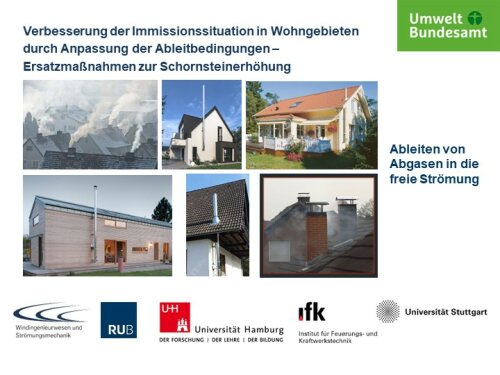
In September 2023, Dr Cornelia Kalender, together with Prof Bernd Leitl from the Meteorological Institute at the University of Hamburg and her colleague Dr Ulrich Vogt from the Institute of Combustion and Power Plant Technology at the University of Stuttgart, acquired an R&D project from the Federal Environment Agency.
The discharge of exhaust gases from small combustion plants in urban areas influences local and neighbourhood air quality. In the two-year project, various dispersion scenarios are being analysed in wind tunnel tests and with numerical flow simulation. In addition to different building shapes and arrangements, the release location on the roof due to the position of the chimney plays a role. Discharge conditions are specified and analysed in conjunction with the building circulation. A comprehensive test and literature study will be carried out to investigate whether unfavourable discharge conditions can be compensated for by technical measures on the combustion furnace.
A Comprehensive Study on Transition Profiles in the Atmospheric Boundary Layer.
We are happy to announce that we will participate in the WIndactions by CHanging the ground ROUGHness (Which Rough) project within the Engineering Research Infrastructures for European Synergies (ERIES) framework (https://eries.eu/).
The Committee includes five European universities and ten researchers, all active in the field of Wind Engineering but with different specific backgrounds. We are looking forward to work with our colleagues from Polytechnic University of Bari, the University of Campania, the University of Stavanger in Norway and Kraków University of Technology.
Larger and taller wind turbines are characterized by larger tip masses and longer rotor-nacelle assembly (RNA) masts. Both result in a lower natural frequency, lowering the critical wind speed and increasing the likelihood of vortex resonance. While freestanding towers, such as stacks, have been extensively investigated for vortex-induced vibration (VIV), the completed wind turbine as a structure has not yet been fully investigated for VIV.
Slender structures subjected to vortex-induced vibrations experience an aeroelastic interaction in the lock-in range. The negative aerodynamic damping is the governing parameter for the onset of self-induced vibrations. However, available literature models still lack of a unified behaviour of the aerodynamic damping as a function of the oscillation. This is also reflected in codified methods to design slender structures in view of cross-wind actions.
Tornadoes pose a significant threat worldwide, with the advancement of technology over the last 30 years leading to increased detection of weather events and subsequently, documented tornado occurrences globally. While commonly associated with the United States, tornadoes also occur in numerous regions across South America, Europe, and Asia, including Germany. Their rapid onset and localized yet devastating impact make them a significant danger to human life and infrastructure.
Like giant chimneys, they could one day rise into the sky - in desert regions, for example - and supply the world with electrical energy at virtually "zero cost". Against all the prophecies of doom, various groups of engineers around the world are now working to bring an ingenious idea out of the realm of visions and into the present - or at least into the near future - thanks to modern reinforced concrete construction and wind engineering technologies.